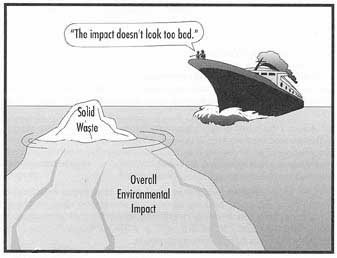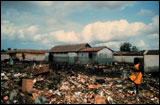 |
||
|
||
|
|
||
|
Overview Indicators In general, the trend is that waste generation per person in high-income countries is much lower than in lower-income countries. However, as incomes increase, the amount of waste increases. Waste from high-income countries is less dense from more packaging and lighter materials being discarded, and has less food waste. Impacts Failure of an effective approach results in wastes dumped along roads, riverbanks, abandoned quarries, with the inevitable effect of contaminating water supplies as well as the whole aquatic chain. Animals grazing on dumps can pass on diseases via the food chain. People living near dumps are also at risk. Air pollution is another factor to be considered. |
||
 |
||
|
Strategies Behavior modification of the general community is an essential component of any solution. Separation of waste for efficacious recycling and environmentally friendly purchasing habits are two areas for effective management. Open dumping is mistakenly believed to be the cheapest method of disposal. Only when landfills can isolate waste from the environment is it considered safe. Composting is an option but generally unsuccessful at a larger scale in middle and low income countries. It can be useful at the ‘backyard’ scale and in large facilities in higher income countries. Incineration not generally common, but used in areas of high land costs. Costs tend to be inversely related to income: in low income countries, often 80-90 percent of the a municipal budget goes to collection of waste. In high income countries, less than 10 percent is for collection, and waste treatment facilities represent the highest cost component. Collection of fees to cover costs vary from direct charges to users to incorporation into a general overall tax. Collection can be problematic and must be carefully studied. The basis for assessing costs to users should be based on waste generated. Initiation of fees should start with the business community. Quality of service desired and a general environmental health concern should feature in the fee structure. Private sector involvement should be encouraged. Commercial, institutional, and industrial waste collection can usually be self-financing, and here the private often plays a role. Waste should be also seen as a ‘resource’ and not just a problem. Regional approaches should also be considered. |
||
See also: "Strategic Planning Guide for Municipal Solid Waste Management". |
||
|
